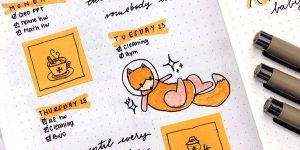A Bullet Journal can solve many of your organizational problems. Instead of 100 sticky notes, digital and analog notes, calendars, to do lists and an endless paper economy, the Bullet Journal is simply everything in one: calendar, notebook, diary, sketchbook – and precisely the way you need it.
Its inventor Ryder Caroll calls it “The analog system for the digital age.” The Bullet Journal System includes several modules that you can customize to your needs.

It is a “customizable and forgiving organization system” – flexible and adaptable. Since the user builds each page, one can change the design of the individual elements. If you make a mistake then no problem, your Bullet Journal will forgive you.
The Bullet Journal system is straightforward. There are no categories or specific pages for specific topics. To get started, you need a blank notebook and a pen for this paper planning. Nothing else!

Individual organization in Bullet Journal
Bullet Journal notebooks, for example, from Leuchtturm1917, are simple in their raw version. There are ready-made pages like the table of contents, and all the other pages of the Bullet Journal have page numbers and a dotted line.
With our overview, you will find out which Bullet Journal elements are suitable for you and which are not. For the sake of simplicity, we group the terms in their meaningfulness and not in alphabetical order, as is usual with a common lexicon.

Index
A notebook that is a planner, diary, and coloring book in one can quickly become confusing. The index is the remedy and is your table of contents. It is at the beginning of a bullet journal and is a simple listing where you write all your entries bit by bit.
To maintain your index, it is essential you take care to number each individual page in your notebook. Sometimes this numbering is already provided, e.g., in the Leuchtturm1917 notebooks. However, if you use any other notebook, definitely think about the page numbers!
Like any other index, the table of contents serves as a guide. With the help of the index, you can quickly find all-important pages again.
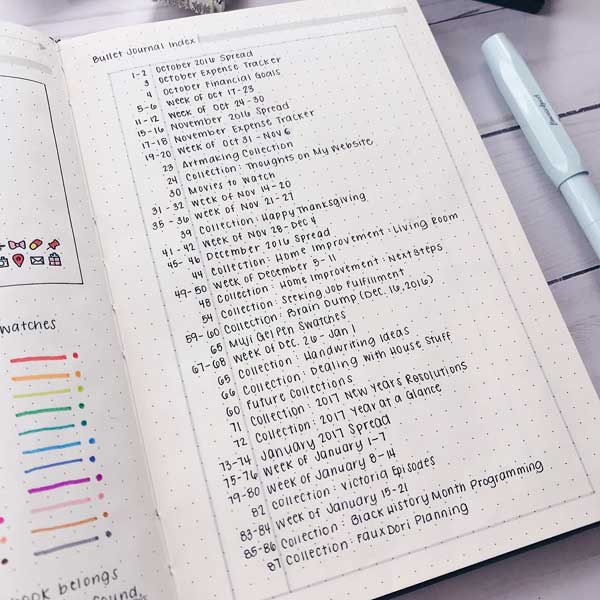
Journaling
Journaling is about the actual writing of your experiences, feelings, thoughts, daily logs, and plans by hand. Your handwriting does not have to be beautiful, only legible for you. In the first place, you write down your thoughts, notes, tasks, etc. for yourself.
Writing by hand and daily journaling helps you to reflect on yourself. You get to know your why, how you approach things and in which thought loops you are so stuck. Anyway, I feel that I can approach structured things better when I have written them down.
I’ve also got used to the fact that when I think about something again and again in bed in the evening, and I can’t let it go, I write it down. My Bullet Journal is actually always ready to handle.
It also varies a lot how much I take notes about my thoughts. Sometimes I write whole sentences like in my diaries earlier or sometimes just the most essential information in the Bujo style.

Plan
Planning works very well in your Bullet Journal. Simply use the Future log for long-term appointments, events or projects and complete the migration or transfer of tasks and notes daily.
Another big part of the planning, whether it’s the next vacation or the next project, is the brain dump. Here it is worthwhile to write in a brainstorming session, everything that comes to mind, what you plan to do or what you have to think about. Only then should you sort the thoughts into categories, which you can then edit or put into a chronological order.
At first, this feels like double work. However, I know and often experience that brainstorming frees you from thinking in specific fixed categories.
Again, it is vital that you include specific time-critical tasks, such as booking a vacation, in the annual plan or the monthly plan or the daily schedule. Because we usually book our vacations or travel tickets a little earlier than we pack our bags.

Rapid Logging
When you rapid log, you write everything in short form, similar to a telegram style using your mini-symbols. The idea is that you do this every day and record everything important to you.
A new appointment comes in, you think of a task, or you think of what you want to research again soon – write everything down. In the evening or on the weekend, you’ll be able to reflect on and transfer your notes and tasks.

Future Log
The Future Log is a long-term, chronological overview. Usually, we create it annually or half-yearly.
The future log usually contains things arranged in such a way that you can quickly take a glance and do not forget them. Doctor’s appointments given months in advance, birthdays, anniversaries or planned vacations are some examples you can include.
For each month you plan, enter all upcoming events and leave some space for the activities you may remember later. Here you can also use the typical key or legend, i.e., bullet points for tasks and circles for appointments or events.
It is unnecessary to plan the whole coming year as your Bullet Journal will probably not last that long. Six to eight months should be enough. After that, you will probably plan in a new notebook.

Monthly Log
The monthly overview heralds the next month in the Bullet Journal. When the new month starts, you create a monthly run-through. This can be, e.g. in the form of a calendar overview with dates. Therefore, you can see when what is due. It’s up to you how decorated or minimalist your monthly summary is.


Weekly Log
The Weekly Log works like the Monthly Log, just for a week instead of a month. Here you can date tasks and describe them. Again, take the space you need. Some use only one side for the weekly log, while others may take up four pages. However, if you do not want to use a weekly record, you can jump directly to the Daily Log.
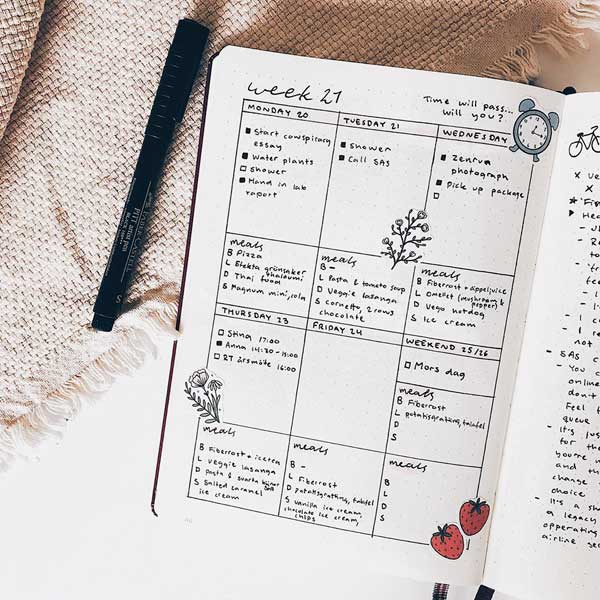
Daily Log
We only create the Daily Log for a specific day, and it does not go beyond that. You do not create these far in advance, but in the best case always the evening before.
We enter all tasks and appointments that occur on the corresponding day. To make sure you forget nothing, it’s worth looking at your Future Log and the monthly overview – everything necessary is already there.
It makes no sense to work with all logs listed here. A combination of, for example, Future, Monthly and Daily Logs or Future, and Weekly Log is suitable for many purposes. Test different combinations to find out how detailed your logs should be.


Transfer aka Migration
Migrating is another essential element of the Bullet Journal System. Transferring notes and tasks enables your active reflection on the importance and progress of these tasks.
At first, it seems like writing things repeatedly. However, it works really well. This also makes it possible to write everything in its “right place” at every moment, e.g., the year overview, the series list, etc.
Reflecting and migrating long term tasks takes place every month when you set up your new monthly overview. Then one goes through all the entries from the Future Log and looks at the open tasks. Short term tasks can be migrated on a daily basis.
Now you decide what to take with you into the new month or leave it at that. You can cross out the jobs you have completed or that are no longer needed. You also mark the tasks that you move or transfer, with an arrow.
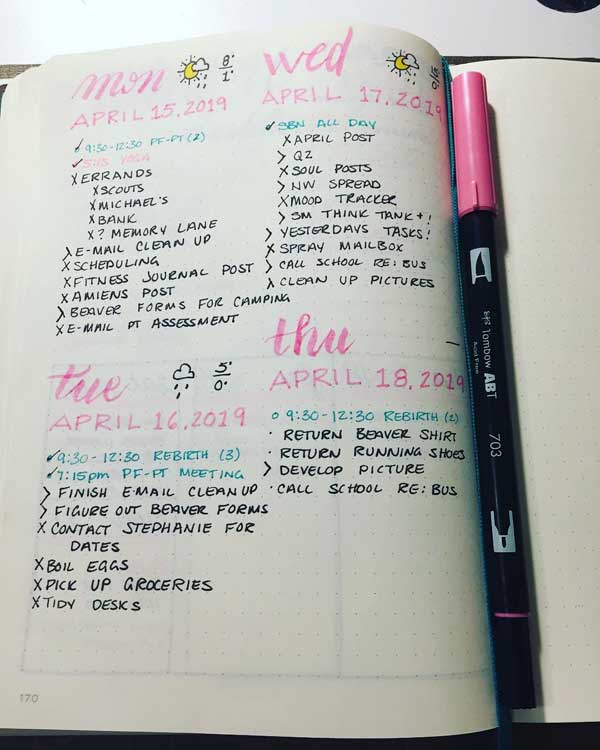
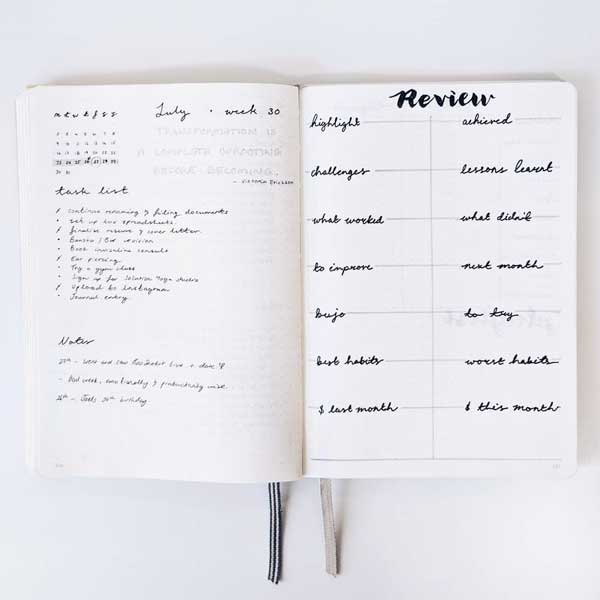
Symbols and Signifiers
These terms are signs you use as abbreviations. Think of simple icons you can use to identify tasks and to-do’s in the logs, for example, “to-do”, “started”, “done”, “moved”, “deleted,” etc. You can also use colors as meaningful symbols! In the Bullet Journal of Leuchtturm, there is already a small overview with suggestions which symbols you could use and how.

Key or Legend
The Bullet Journal key is the directory with which you can interpret the symbols you have created. The key page is usually located at the beginning or end of the Bullet Journal, and you can quickly look up which symbol should mean what.

Habit Tracker
Besides being a calendar and notebook, your bullet journal can become anything you want. The Habit Tracker is a popular feature for getting used to good habits or getting rid of bad ones. Would you like to go to bed early or do yoga regularly? Within your Weekly or Daily Log, keep track of how many hours you have spent in bed each night or how often you have made it to the yoga mat!

Challenges
Challenges are relatives of the Habit Tracker as they also help you achieve specific goals. Would you like to quit smoking? Try to draw something in an overview page on the day you haven’t smoked – you can easily integrate a personal reward system here.

Collections
A Bullet Journal collection is a list in the broadest sense. For example, movies you’ve always wanted to watch, books you’ve always wanted to read. You can also record Birthdays or travel destinations here! As soon as you read a book or watch a film, you can check it off.
There are many creative ways to create collections (and all other Bullet Journal pages). Artistically gifted people can, for example, draw a bookshelf on the pages and write the desired title on each spine. Once they finish the book, they can color the spine. Thus, a black-and-white drawing gradually grows into a colorful work of art.
To create a new collection, just write on the next free page with a heading over it and write everything that goes with it. Note it down in the index, and you’re done.

Time Log / Tracker
Time logs are time trackers. These are reviews that record what you do during the day. It is a glimpse of how you spent your day and an overview of daily activities you carried out such as sleep, work/school, leisure, social life.
This will help you know how much time you spend on what activity and also calculate how much free time you have each day.

Year in Pixels – Your Year in Boxes
Having your whole year in check boxes at a glance allows the idea of “Year in Pixels.” Each day of the year gets a box. We display the complete overview on one page. We create a color code that represents certain things we want to have mapped. Often, we track the moods over the year or productivity. At the end of a year, you will have a colorful overview of the year.

Spread and setup
A spread or layout is a wholly designed page, and the setup is the overview of the structure of a bullet journal or a particular section. Journalers all over the world showcase their Bullet Journal layouts on various social media sites.
The Bullet Journal community is very active on social networks around the world. If you need creative inspiration, you can browse multiple webpages, Instagram profiles, or Pinterest walls. Journalers reveal and show ideas gladly in these networks.


Sketch notes
Sketch notes are small drawings, icons, doodles and pictograms with which we can embellish the pages in the Bullet Journal.

Set goals
I found a great approach to setting goals in Ryder Carroll’s book The Bullet Journal Method.
First, we should write all the goals that come to our mind as in a brainstorming session. Next, we sort the goals by personal and professional goals in a 5-4-3-2-1 scheme. We classify brainstorming goals according to the time we will need to fulfill them – 5 years, 4 months, 3 weeks, 2 days, 1 hour. Then you choose from each of the categories a goal that really resonates with you.
After that, proceed immediately to implementing those goals. We should transfer the goals, we had timed to 2 days or 1 hour into the daily log. For longer-term goals, create a collection or create additional lists to continue working on it and possible further steps to edit.

Ghosting and Bleeding
If the paper is rather thin, and the pen gives out a lot of ink, it may lead to a blot. This means the pen presses the ink through to the back of the paper. Sometimes the writing is faintly visible on the other side of the paper. We call this phenomenon ghosting – but this should not happen with high-quality Bullet Journal notebooks.
If the ink penetrates the paper and is visible on the other side, then we call it bleeding. Bleeding is annoying, and that is why you need to choose your stationary carefully. Perform some tests with various notebooks and pens before you log your day.

BuJo
BuJo is a loving abbreviation for Bullet Journal.
Dot Grid
Dot grid means point grid. Notebooks have different rulings like checkered, lined, dotted, or blank. Many people who use BuJo’s prefer the point grid. In principle, however, every ruling is suitable. That is a matter of taste.

Stationary
Oh, all the nice pens, markers, stamps and stickers, washi tape and whatever other BuJo accessories you can think of. 😉 Depending on the style you want to keep your Bullet Journal in and how elaborately you decorate it, you need different materials. Basically, a notebook and a pen will do.

Level 10 Life
“Level 10 Life” or “Wheel of Life” is a system with which one can follow one’s own personality development in different areas of life and realize it. We note ten areas of life.
First, one makes oneself conscious of how content one is in their respective regions. The big goal is to be on level 10 in all areas. You can also show the percentage of completion. One then also realizes how vital these areas are in each case.
Common areas are, e.g., relationship/partnership, family/friends, creativity, fitness/health, leisure/recreation, job/career, finances, living environment, society, commitment, and spirituality. However, you can also simply add others that seem relevant and meaningful to you.
It’s about thinking about what resources have been available so far that have already led to higher levels in suitable areas and what else we can do to reach level 10.

Don’t get too perfectionist
Don’t let the photos of many beautiful Bullet Journals circulating on the web unsettle you. First, a Bullet Journal should support you in your everyday life. If you have fun designing it creatively, that is great.
However, that does not have to be the case. Even minimalist bullet journals serve their purpose. It is also no big deal if you reject ideas, change your structure, or overturn projects. A Bullet Journal reflects your life and it can adapt flexibly.
It only has to work for you alone and doesn’t have to look “nice” at all. But, you can make it elaborate if you wish to show some creativity.

The original Bullet Journal System from Ryder Carroll includes some features that make up the Bullet Journal. However, it’s a versatile system that everyone can adapt to their own needs!
So if you’d instead use other symbols for your legend, do it. Design your Future Log so it suits you best and you like to come back to it. It won’t help if you never use it.
Ryder Carroll’s Bullet Journal is minimalist and clean. However, if you’d like to decorate yours or use beautiful fonts, do it. After all, you would like to use your bullet journal every day!
How well do you know the basic Bullet Journal concepts? Take a free BuJo quiz to find out!





